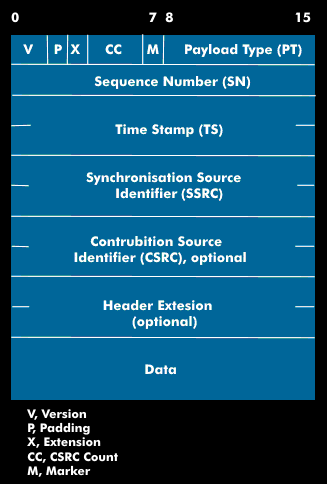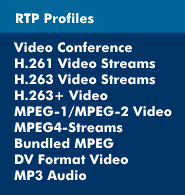RTP header
The header of the RTP protocol(Realtime Transport Protocol) is always sent after the IP header or the UDP header and comprises at least 12 octets.
The version number (V) of the RTP protocol is transmitted inthe first, two-bit short version field (V). This is followed by a 1 bit short padding field(P). The following extension field(X) indicates that the RTP protocol has an extension. The following 3 bit long CC data field is used for the CSRC count (Contribution Source). It contains the number of CSRC fields. The marker (M) can be used to mark the beginning of a stream in the payload. The eight-bit Payload Type( PT) data field identifies the type of data in the payload. This can be a video stream according to H.261 or H.263, MPEG-4, MP3 audio or other file formats. The following sequence number( SN) is used for sequence control and is incremented by one counter for each data packet, as in the TCP protocol.
To synchronize audio or video, the RTP protocol uses a timestamp specified by the respective RTP profile. The time stamp for this synchronization is entered in the 4 octets Timestamp( TS) data field.
To uniquely identify the data source, the RTP header has the 32-bit Synchronization Source (SSRC) data field, which is used to identify the synchronization source during an RTP session. In the second optional data field, the Contribution Source (CSRC), which comprises several octets, the source addresses of the SSCRs are entered.
Another optional data field is the Header Extension, which can also be several octets long. The presence of this data field is indicated by the entry in the X data field. The header extension enables the transmission of data that does not correspond to the specified data profiles.


